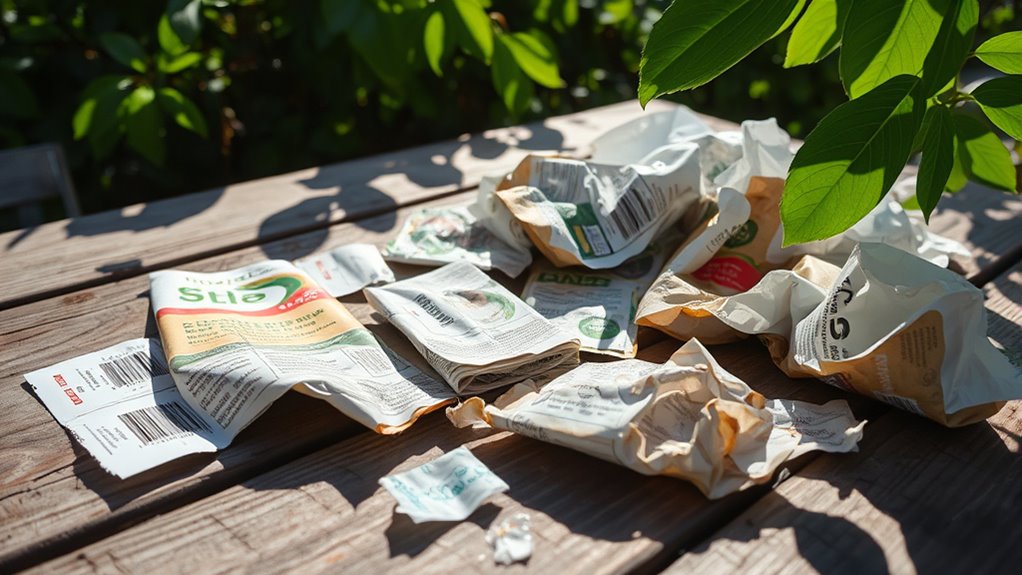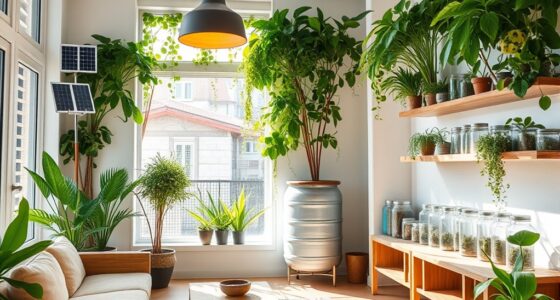Biodegradable products aren’t always as eco-friendly as they seem. They’re designed to break down naturally, but factors like environmental conditions, composition, and disposal methods greatly affect how quickly and completely they decompose. Many claims are exaggerated or misleading, with some products taking years to break down or only doing so in industrial facilities. If you want to discover how to spot truly sustainable options, keep exploring these key points.
Key Takeaways
- Not all biodegradable products decompose quickly or completely; environmental conditions greatly influence their breakdown.
- Many products labeled “biodegradable” require industrial composting facilities, not achievable in home settings.
- Greenwashing and false claims can mislead consumers into believing products are eco-friendly when they are not.
- Proper disposal and understanding of biodegradation processes are essential to genuinely reduce environmental impact.
- Choosing certified, compostable, or recyclable products supports true sustainability over hype.
What Does “Biodegradable” Really Mean?
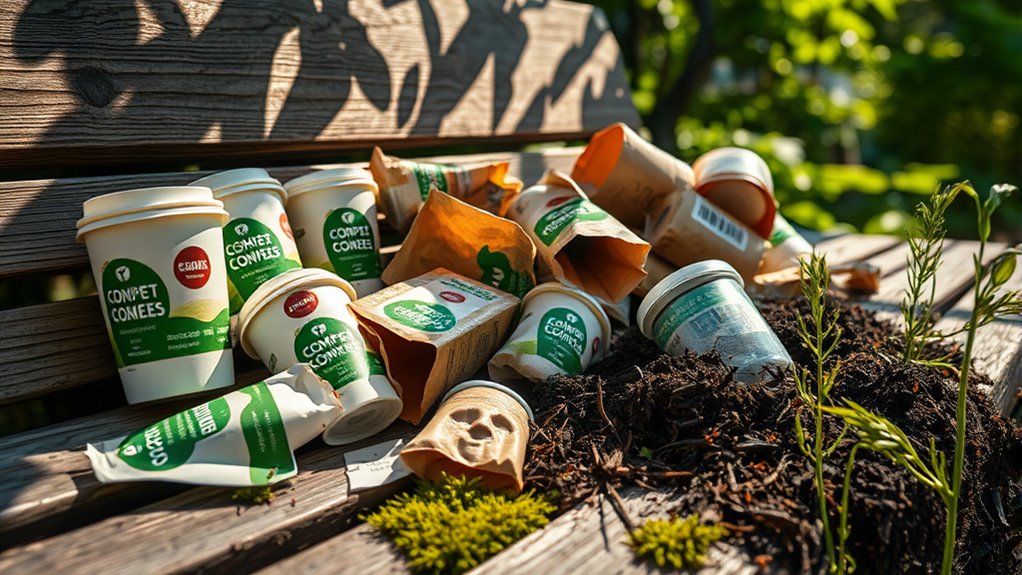
What does “biodegradable” really mean? It sounds straightforward, but it’s more complex than you might think. Biodegradable products are designed to break down naturally, but the process isn’t always simple or quick. Recycling challenges often prevent many items from being reused efficiently, leading to more waste in landfills. Composting methods can help speed up decomposition, but they require specific conditions like temperature, moisture, and oxygen. Not all biodegradable items decompose in a typical landfill environment, which can give a false impression of eco-friendliness. So, just because a product is labeled biodegradable doesn’t guarantee it will break down easily or quickly. Understanding these nuances helps you make smarter, more environmentally conscious choices. Additionally, forsale 100 options are often marketed as eco-friendly without clear evidence of their biodegradability.
The Science Behind Decomposition
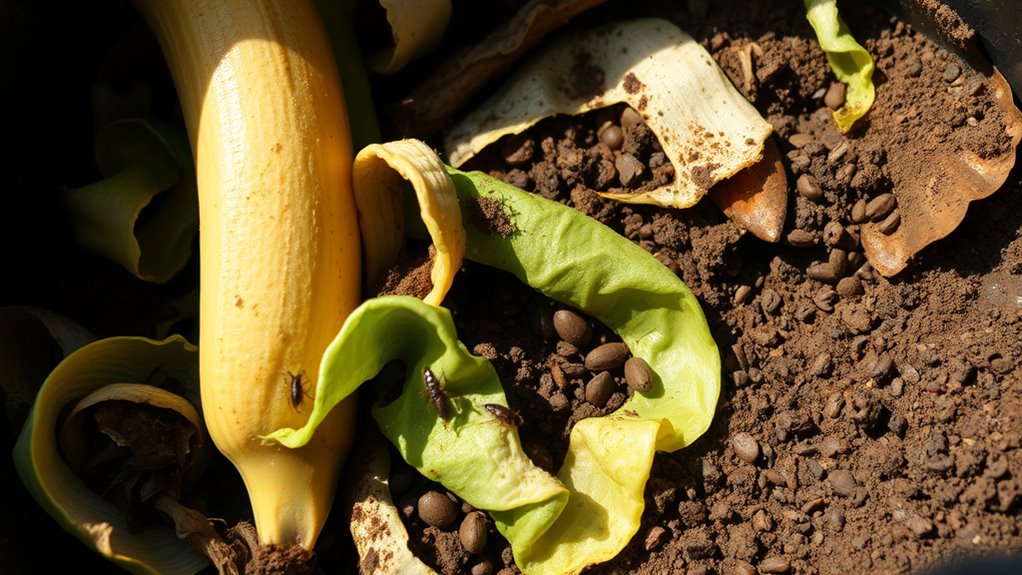
Have you ever wondered what actually happens when a biodegradable product begins to break down? It all starts with microbial activity. Microorganisms like bacteria and fungi feed on the material, breaking it into smaller compounds. The decomposition time varies depending on factors like temperature, moisture, and the material’s composition. In ideal conditions, microbes rapidly consume biodegradable products, transforming them into water, carbon dioxide, and organic matter. Additionally, environmental conditions such as temperature and humidity significantly influence the speed of biodegradable breakdown. However, if conditions aren’t *best*, decomposition can take much longer, sometimes years. Your environment plays a critical role in this process. Understanding how microbial activity influences decomposition helps explain why some biodegradable items break down quickly, while others linger. Ultimately, the science shows that biodegradation isn’t instant—it’s a biological process influenced by numerous environmental factors.
Types of Biodegradable Materials
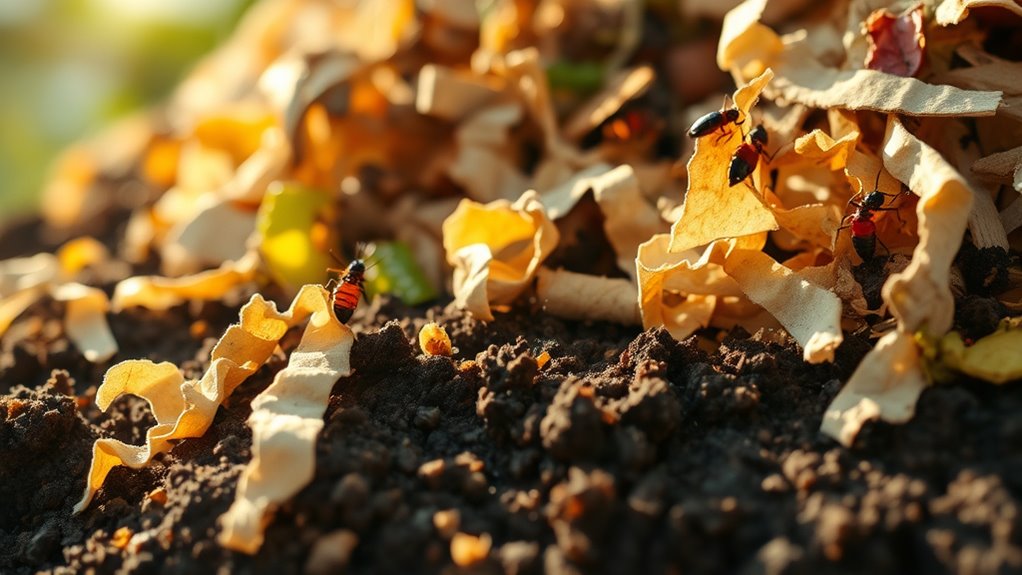
You’ll find that biodegradable materials come in different forms, including various types of polymers. Some are natural, like starch or cellulose, while others are synthetic but designed to break down safely. Understanding these options helps you choose the right materials for sustainable products. Additionally, ongoing research in innovative materials aims to improve biodegradability and reduce environmental impact.
Biodegradable Polymer Types
Did you know that biodegradable polymers come in various types, each with unique properties suited for different applications? Some are made from natural sources like starch, cellulose, or polylactic acid (PLA), which break down more easily in the environment. Others are synthetic but incorporate biodegradable additives to enhance their decomposition. You might also encounter polymer blends, combining different biodegradable materials to optimize strength, flexibility, or degradation rates. For instance, blending PLA with other bioplastics can improve performance while maintaining eco-friendliness. These different types allow manufacturers to tailor products for specific uses, from packaging to agricultural films. Understanding the distinctions helps you make informed choices about biodegradable products, ensuring they meet environmental expectations and perform effectively in their designated roles. Biodegradable materials vary widely in their composition and environmental impact.
Natural Vs Synthetic Options
Biodegradable polymers can be classified into natural and synthetic options, each offering distinct advantages and characteristics. Plant-based alternatives, such as cornstarch, cellulose, and polylactic acid (PLA), come from renewable resources and are typically biodegradable under natural conditions. These natural options are often preferred for their environmental friendliness and minimal synthetic processing. On the other hand, synthetic materials like polybutylene succinate (PBS) and polyhydroxyalkanoates (PHA) are engineered to provide specific properties, such as durability or flexibility, while still biodegrading over time. While plant-based alternatives tend to be more sustainable, synthetic materials can be tailored for particular applications. Understanding the biodegradation mechanisms of different materials helps in selecting the most appropriate option for environmentally conscious products. Your choice depends on factors like environmental impact, performance needs, and manufacturing processes, making it essential to understand the differences between natural and synthetic biodegradable options.
Environmental Impact of Biodegradable Products
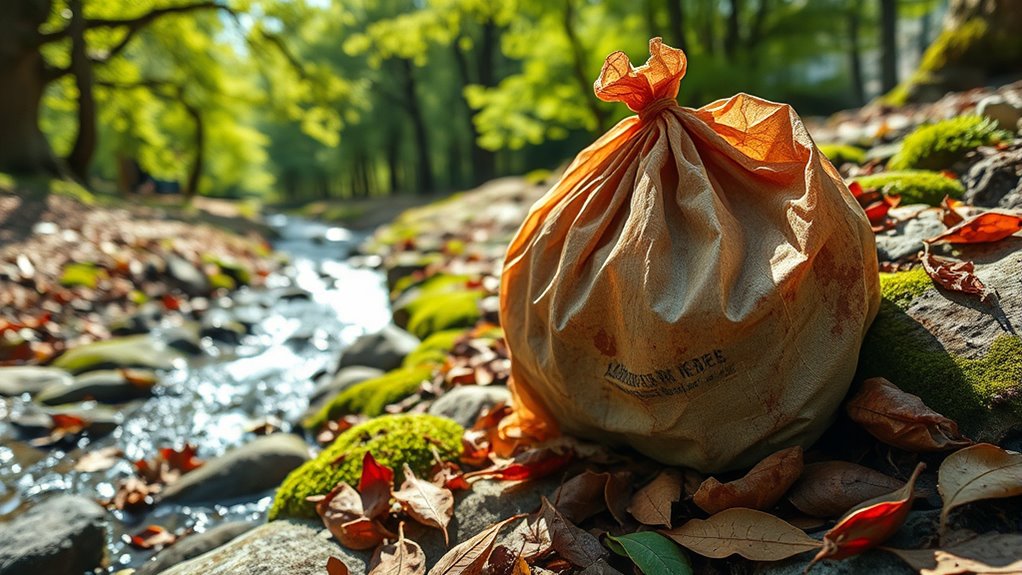
While biodegradable products are often praised for their environmental benefits, their actual impact depends on various factors such as material composition and disposal methods. If not properly managed, they may still contribute to packaging waste that ends up in landfills. Biodegradable items can break down faster than traditional plastics, but only under specific conditions, like industrial composting facilities. When disposed of improperly, they may persist in landfills, adding to landfill impact without breaking down fully. Additionally, some biodegradable products contain additives that affect their decomposition process or release harmful substances. Your choices matter—using biodegradable products responsibly and ensuring proper disposal can help minimize their environmental footprint and reduce their contribution to waste accumulation. Proper disposal methods are crucial to ensure these products break down as intended and truly benefit the environment.
Common Misconceptions and Greenwashing
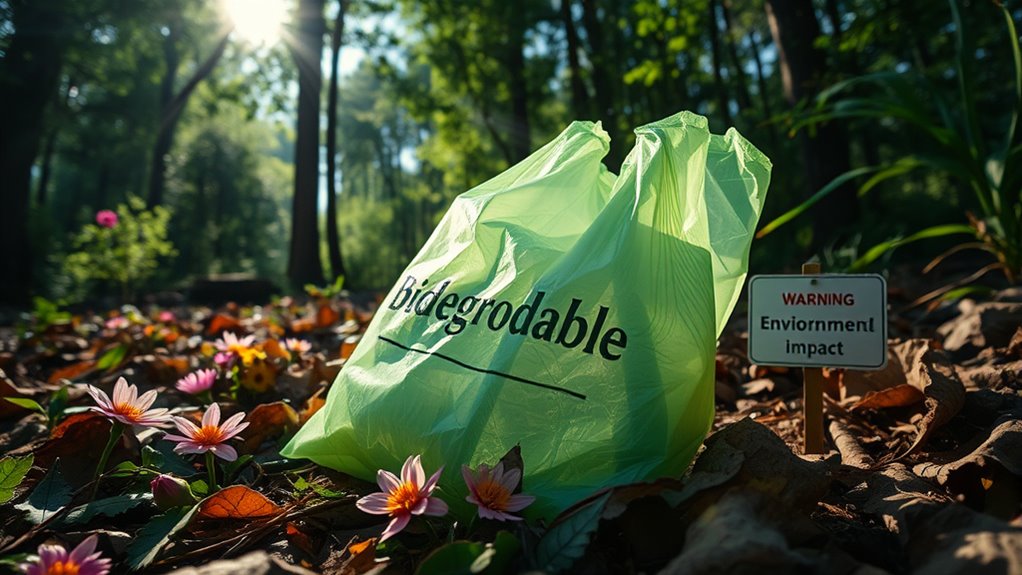
Many products claim to be biodegradable, but some use greenwashing tactics to mislead you about their true environmental impact. Labels can be confusing or false, making it hard to tell which products genuinely break down safely. Understanding actual biodegradation rates helps you make better, eco-friendly choices. Additionally, being aware of potential pitfalls in adopting new payment technologies can help consumers and businesses navigate the complexities of environmentally friendly products and services.
Greenwashing Tactics Revealed
Greenwashing tactics can easily mislead consumers into believing a product is eco-friendly when it’s not. Many companies exploit biodegradable myths to create a green image, even if their products don’t break down naturally. They use eco label tricks, such as vague or misleading certifications, to give the illusion of sustainability. These labels often lack strict standards or transparency, making it hard for you to verify their claims. You might see phrases like “biodegradable” without context or timeframes, which can be deceptive. Additionally, vertical storage solutions and other organization tactics are often promoted as environmentally friendly, but without proper verification, they can be part of greenwashing. By understanding these tactics, you can better identify when a company is overstating its environmental efforts. Don’t be fooled by surface-level claims; look deeper to see if their practices truly support sustainability or if they’re just riding the greenwashing wave.
Misleading Labeling Practices
Misleading labeling practices can give consumers a false sense of security by disguising products’ true environmental impact. Many products labeled as “biodegradable” or “green” don’t break down easily, contributing to plastic pollution. These labels can be confusing, making you believe you’re choosing eco-friendly options when you’re not. To visualize this, consider:
- A plastic bag littering a beach, taking decades to decompose.
- Packaging marked “compostable” that requires industrial facilities to break down.
- Labels claiming “biodegradable” but offering no proof or certification.
Such tactics can mislead you into ignoring the importance of consumer awareness about actual biodegradation rates. The result? Increased plastic pollution, and a false sense that you’re helping the environment, when in reality, some products just prolong pollution problems. Furthermore, certifications and endorsements from beauty experts can serve as indicators of genuine eco-friendly claims.
Actual Biodegradation Rates
Understanding actual biodegradation rates is essential because many products labeled as “biodegradable” do not break down as quickly or completely as you might expect. In reality, biodegradation depends heavily on specific degradation conditions, such as temperature, moisture, and microbial activity. Composting challenges often hinder proper breakdown, especially in home compost setups that lack ideal conditions found in industrial facilities. Products may appear to degrade, but they can leave behind microplastics or other residues if conditions aren’t perfect. Greenwashing companies may claim rapid decomposition without providing evidence or considering real-world environments. Recognizing these factors helps you avoid misleading labels and make informed choices about which products truly minimize environmental impact over time. Additionally, biodegradation rates can vary significantly depending on the material composition and environmental context, making it crucial to look beyond labels for accurate information.
How to Identify Truly Eco-Friendly Options

How can you tell if a product truly lives up to its eco-friendly claims? Look for certification labels from reputable organizations, as they verify environmental standards. Check if the product promotes recycling benefits by being easily recyclable or made from recycled materials. Also, consider composting methods; eco-friendly products should break down naturally in compost without leaving harmful residues. To identify genuinely sustainable options, imagine:
- A package that easily fits into your recycling bin, ensuring simple recycling benefits.
- Compostable items that decompose quickly in your compost pile, supporting composting methods.
- Labels indicating the use of biodegradable materials, but only if they meet verified standards. These steps help you avoid hype and choose truly eco-friendly products that contribute positively to the environment.
Making Informed Choices for a Sustainable Future
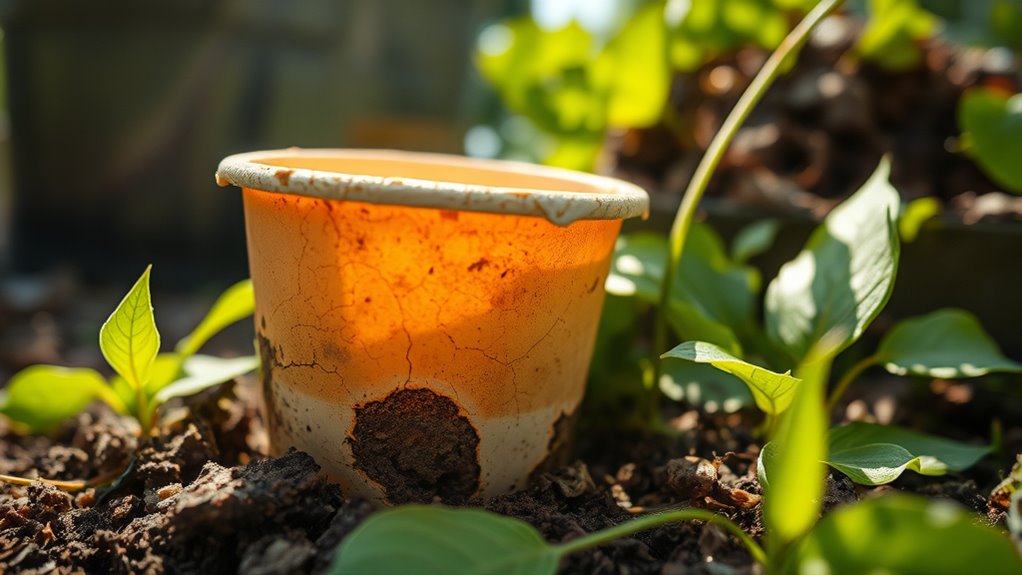
Making informed choices is key to building a sustainable future. First, avoid falling for recycling myths that suggest all plastics are eco-friendly; instead, focus on reducing waste whenever possible. When considering biodegradable products, understand that composting techniques matter—some items require specific conditions to break down properly. Educate yourself on proper composting methods to ensure your organic waste truly decomposes and doesn’t contribute to landfill issues. Look for products with transparent labeling and certifications that verify their eco-claims. By making conscious decisions, such as composting correctly and avoiding misconceptions about recycling, you help reduce environmental impact. Your choices directly influence the demand for sustainable options, encouraging manufacturers to prioritize genuine eco-friendly practices. Small, informed actions lead to meaningful, long-term change.
Frequently Asked Questions
Do Biodegradable Products Break Down in Landfills Effectively?
You might wonder if biodegradable products break down in landfills effectively. Landfill conditions often lack enough oxygen and moisture, which slows decomposition rates. As a result, biodegradable items may take years or even decades to decompose, if at all. While they’re designed to break down faster in ideal environments, in most landfills, their decomposition is limited. So, it’s unlikely they fully decompose quickly without proper conditions.
How Long Does It Typically Take for Biodegradable Items to Decompose?
Imagine a banana peel decomposing in a few weeks, but a plastic bag taking decades. Biodegradable items generally break down in months to a few years, depending on composting challenges and environmental conditions. Biodegradation rates vary widely—some decompose quickly in industrial composters, while others linger in landfills due to lack of oxygen and moisture. So, your biodegradable product’s decomposition time hinges on where and how you dispose of it.
Are All Biodegradable Plastics Truly Environmentally Friendly?
You might think all biodegradable plastics are eco-friendly, but that’s not always true. Some claim to be biodegradable yet still contribute to plastic pollution because they require specific conditions to break down. Depending on how they’re produced and disposed of, they may not fully reduce environmental impact. So, always question eco-friendly claims and consider whether biodegradable plastics genuinely help combat plastic pollution or just give false hope.
Can Biodegradable Products Be Safely Composted at Home?
You can safely compost biodegradable products at home if you follow proper composting guidelines. Make sure the items are labeled as compostable and avoid adding plastics that don’t break down easily. Use a balanced mix of green and brown materials, keep the compost moist, and turn it regularly. Home composting works best when you stick to these guidelines, ensuring your biodegradable products break down efficiently and safely in your compost bin.
What Certifications Indicate a Genuinely Biodegradable Product?
You might wonder which certifications prove a biodegradable product’s authenticity. Investigating this, you’ll find that certification standards like ASTM D6400, EN 13432, and BPI confirm products meet strict biodegradable criteria. However, eco label reliability varies, so always check for recognized standards. These certifications guarantee your eco-friendly choices truly break down and aren’t just marketing hype, giving you confidence in your sustainable decisions.
Conclusion
Think of biodegradable products as seeds—you need the right environment to truly grow and benefit the planet. Not all seeds (or products) are created equal, and some might just be false promises hiding in plain sight. By digging deeper and choosing genuinely eco-friendly options, you’re planting the roots for a healthier Earth. Stay informed, ask questions, and nurture sustainability like tending a delicate garden—every conscious choice helps it flourish.
